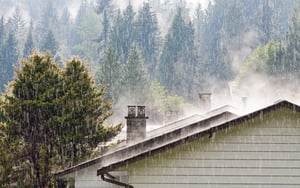
 Summer storms can be intense, whether it’s a passing thunderstorm, hailstorm, or worse, a tornado or hurricane. These storm season preparation tips can help your homeowners ride out bad weather:
Summer storms can be intense, whether it’s a passing thunderstorm, hailstorm, or worse, a tornado or hurricane. These storm season preparation tips can help your homeowners ride out bad weather:
1. Doors, windows and skylights. Gale-force winds create flying debris that can act like bullets, easily passing through windows and sometimes doors. If your clients live in hurricane-prone areas, suggest they consider impact-resistant glass or shutters. Some shutters have a track system that allows you to store them while not in use; then, when a storm approaches, they’re fairly easy to install. Don’t overlook garage doors, either. They may need extra bracing to withstand high winds.
2. Eliminate flying objects. Before the storm, remove outside objects that can become airborne. Don’t assume patio furniture is heavy enough to withstand high winds: recent tornadoes have sent cars flying. If they can’t be moved, then secure these outdoor objects as well as possible.
3. Landscaping. Keep trees and shrubs trimmed of dead branches; prune all trees back to keep a 10-foot safe zone around homes. Monitor any cracks or splitting in trees.
4. Seal tight against water damage. Close and lock doors and windows. Remove window air conditioners. Ensure gutters are debris-free and will carry water away from foundations. If basements are present, your clients should check sump pumps and battery backup to ensure they’re in good working order.
5. Exterior structure. Because hurricane-force winds can easily pull homes apart, starting at the roof, consider a construction fastening system. In hurricane-prone areas, install hurricane straps to strengthen roof-to-wall and wall-to-foundation connections. Properly brace roof trusses. Depending on the home’s construction, hold-downs, embedded connectors, tie-downs and/or lateral anchors may be recommended; suggest that your client talk with a contractor to learn what’s best for their home.
6. Get ready. Your clients should consider a portable generator to get them through the storm’s aftermath. Keep basics on-hand: portable radio and plenty of fresh batteries, candles, water, non-refrigerated food and a first-aid kit. Make sure friends and loved ones know where they’re riding out the storm. Remind them to have an up-to-date inventory of their home and its belongings, using their smart phone’s video and photo capabilities, and upload these files to the cloud so that they can easily be retrieved.
Hurricane season preparation tips for boats
Whether your boat owners store their watercraft at home on a trailer or in a marina, here are storm season preparation steps they should take to secure their boat and minimize storm damage.
1. Remove the extraneous. Eliminate sails, deck chairs, biminis and any other equipment that may go flying.
2. Storing ashore vs. at a marina. According to Boatus.com and BoatingMag.com, the best place for boats to weather the storm is on shore. Marinas protected only by a low-lying seawall or those with floating docks and short pilings are more susceptible to storm surge. Even if your client’s boat is well-secured, they note, chances are the ones next to them won’t be. Too often boats at these locations have ended up as a cluster of damaged vessels washed ashore.
3. High is not dry. Even if you decide not to store your boat at a marina, never leave a boat in davits or on a hydrolift.
4. If the boat is left at the marina, it should be well-sheltered and have pilings 16-18 feet tall and floating docks. The floating docks allow craft to rise and fall without over-stressing lines. Add extra lines to secure the craft. Also ensure the boat slip is wide enough to allow for surge that won’t pound the craft against pilings. BoatingMag.com recommends: “Anticipate that at least one cleat, piling or line will fail, so give each line a mate running in the same direction but attached at different places on both the boat and dock. To counter rising (or falling) storm tide, bypass the closest cleat or piling in favor of one farther away…. Give each line a mate running in the same direction but attached at different places on both the boat and dock.”
5. If the boat is stored ashore, the location should be out of a low-lying, flood-prone area. It’s best to strap them down to a secure anchor such as a helical anchor drilled into the ground or eyes set in concrete. Use straps with no stretch: that way, leeward jackstands won’t buckle, tipping the boat over.
6. More ways to secure the trailer. Place blocks beneath the trailer frame on either side of the wheels, suggests BoatingMag.com, and then deflate the tires. Tie the boat to the trailer, and then also tie the boat to the anchors.
Whatever type of storm hits your region, we hope these tips will help you get ready for storm season.
Tell us what you think! Do you have any storm tips not listed here? We want to hear from you!






